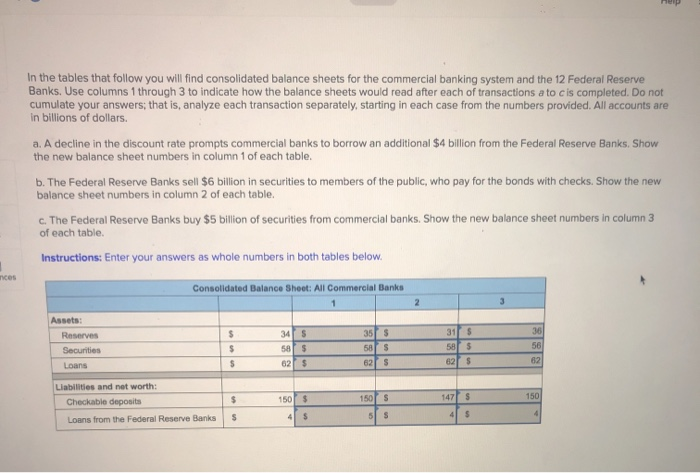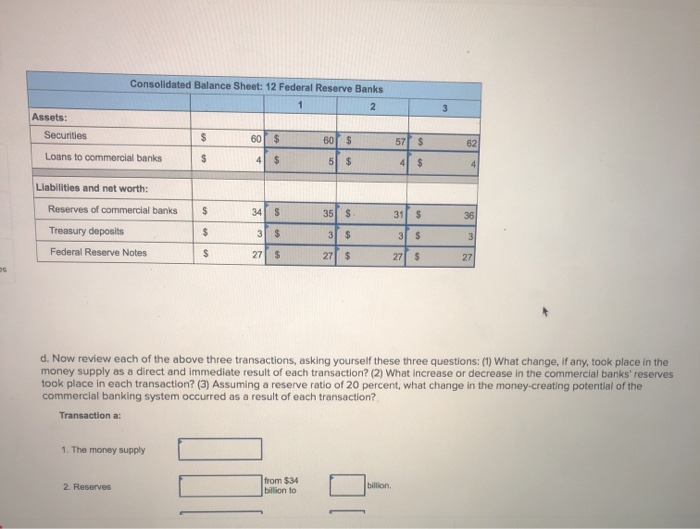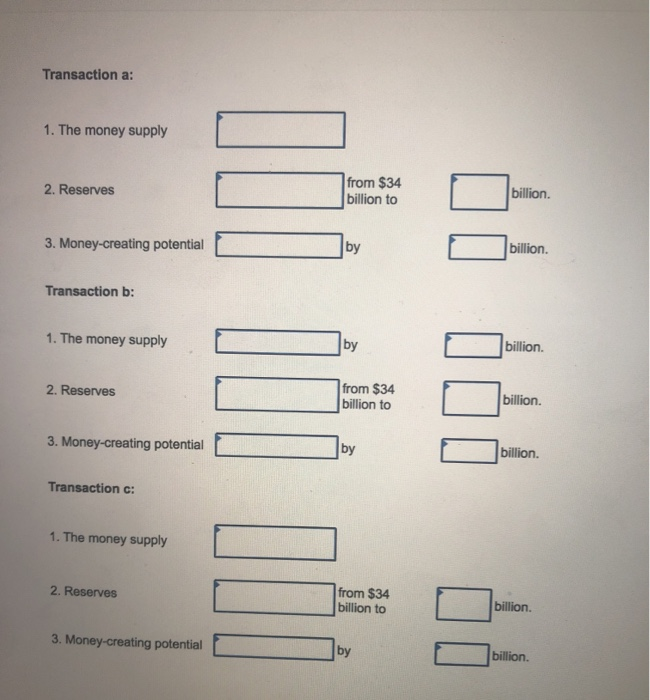In the tables that follow you will find consolidated balance sheets for the commercial banking system and the 12 Federal Reserve Banks. Use columns 1 through 3 to indicate how the balance sheets would read after each of transactions a to cis completed. Do not cumulate your answers; that is, analyze each transaction separately, starting in each case from the numbers provided. All accounts are in billions of dollars. a. A decline in the discount rate prompts commercial banks to borrow an additional $4 billion from the Federal Reserve Banks. Show the new balance sheet numbers in column 1 of each table. b. The Federal Reserve Banks sell $6 billion in securities to members of the public, who pay for the bonds with checks. Show the new balance sheet numbers in column 2 of each table. c. The Federal Reserve Banks buy $5 billion of securities from commercial banks. Show the new balance sheet numbers in column 3 of each table. Instructions: Enter your answers as whole numbers in both tables below. nces Consolidated Balance Sheet: All Commercial Banks 2 3 35s Assets: Reserves Securities Loans $ $ $ 34S 585 62 $ 58 S 31 S 58 $ 62 36 56 62 62 s $ 150 S 150 $ Liabilities and net worth: Checkable deposits Loans from the Federal Reserve Banks 147 S 150 $ S 5 s 4 $ 4 3 Consolidated Balance Sheet: 12 Federal Reserve Banks 1 2 Assets: Securities $ 60 $ 60 $ Loans to commercial banks 4 $ 50 $ 57 $ 62 $ 4 on 4 $ 34 S 35 $ Liabilities and net worth: Reserves of commercial banks Treasury deposits Federal Reserve Notes 31 $ 36 $ 3 $ 3 $ 3 $ 3 $ 27 $ 27 $ 27 $ 27 as d. Now review each of the above three transactions, asking yourself these three questions: (1) What change, if any, took place in the money supply as a direct and immediate result of each transaction? (2) What increase or decrease in the commercial banks' reserves took place in each transaction? (3) Assuming a reserve ratio of 20 percent, what change in the money-creating potential of the commercial banking system occurred as a result of each transaction? Transaction a: 1. The money supply 2. Reserves from $34 billion to billion Transaction a: 1. The money supply 2. Reserves from $34 billion to billion. 3. Money-creating potential by billion. Transaction b: 1. The money supply by billion 2. Reserves from $34 billion to billion. 3. Money-creating potential by billion. Transaction c: 1. The money supply 2. Reserves from $34 billion to billion. 3. Money-creating potential by billion. In the tables that follow you will find consolidated balance sheets for the commercial banking system and the 12 Federal Reserve Banks. Use columns 1 through 3 to indicate how the balance sheets would read after each of transactions a to cis completed. Do not cumulate your answers; that is, analyze each transaction separately, starting in each case from the numbers provided. All accounts are in billions of dollars. a. A decline in the discount rate prompts commercial banks to borrow an additional $4 billion from the Federal Reserve Banks. Show the new balance sheet numbers in column 1 of each table. b. The Federal Reserve Banks sell $6 billion in securities to members of the public, who pay for the bonds with checks. Show the new balance sheet numbers in column 2 of each table. c. The Federal Reserve Banks buy $5 billion of securities from commercial banks. Show the new balance sheet numbers in column 3 of each table. Instructions: Enter your answers as whole numbers in both tables below. nces Consolidated Balance Sheet: All Commercial Banks 2 3 35s Assets: Reserves Securities Loans $ $ $ 34S 585 62 $ 58 S 31 S 58 $ 62 36 56 62 62 s $ 150 S 150 $ Liabilities and net worth: Checkable deposits Loans from the Federal Reserve Banks 147 S 150 $ S 5 s 4 $ 4 3 Consolidated Balance Sheet: 12 Federal Reserve Banks 1 2 Assets: Securities $ 60 $ 60 $ Loans to commercial banks 4 $ 50 $ 57 $ 62 $ 4 on 4 $ 34 S 35 $ Liabilities and net worth: Reserves of commercial banks Treasury deposits Federal Reserve Notes 31 $ 36 $ 3 $ 3 $ 3 $ 3 $ 27 $ 27 $ 27 $ 27 as d. Now review each of the above three transactions, asking yourself these three questions: (1) What change, if any, took place in the money supply as a direct and immediate result of each transaction? (2) What increase or decrease in the commercial banks' reserves took place in each transaction? (3) Assuming a reserve ratio of 20 percent, what change in the money-creating potential of the commercial banking system occurred as a result of each transaction? Transaction a: 1. The money supply 2. Reserves from $34 billion to billion Transaction a: 1. The money supply 2. Reserves from $34 billion to billion. 3. Money-creating potential by billion. Transaction b: 1. The money supply by billion 2. Reserves from $34 billion to billion. 3. Money-creating potential by billion. Transaction c: 1. The money supply 2. Reserves from $34 billion to billion. 3. Money-creating potential by billion









